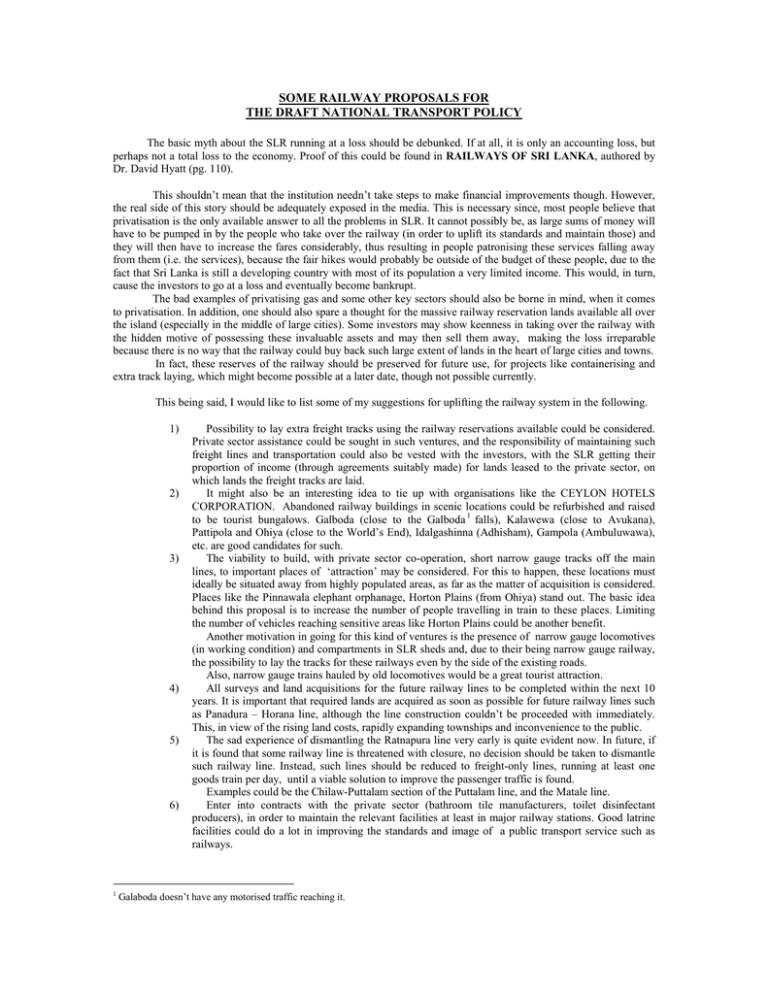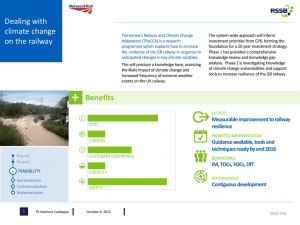SOME RAILWAY PROPOSALS FOR THE DRAFT NATIONAL TRANSPORT POLICY
advertisement

SOME RAILWAY PROPOSALS FOR THE DRAFT NATIONAL TRANSPORT POLICY The basic myth about the SLR running at a loss should be debunked. If at all, it is only an accounting loss, but perhaps not a total loss to the economy. Proof of this could be found in RAILWAYS OF SRI LANKA, authored by Dr. David Hyatt (pg. 110). This shouldn’t mean that the institution needn’t take steps to make financial improvements though. However, the real side of this story should be adequately exposed in the media. This is necessary since, most people believe that privatisation is the only available answer to all the problems in SLR. It cannot possibly be, as large sums of money will have to be pumped in by the people who take over the railway (in order to uplift its standards and maintain those) and they will then have to increase the fares considerably, thus resulting in people patronising these services falling away from them (i.e. the services), because the fair hikes would probably be outside of the budget of these people, due to the fact that Sri Lanka is still a developing country with most of its population a very limited income. This would, in turn, cause the investors to go at a loss and eventually become bankrupt. The bad examples of privatising gas and some other key sectors should also be borne in mind, when it comes to privatisation. In addition, one should also spare a thought for the massive railway reservation lands available all over the island (especially in the middle of large cities). Some investors may show keenness in taking over the railway with the hidden motive of possessing these invaluable assets and may then sell them away, making the loss irreparable because there is no way that the railway could buy back such large extent of lands in the heart of large cities and towns. In fact, these reserves of the railway should be preserved for future use, for projects like containerising and extra track laying, which might become possible at a later date, though not possible currently. This being said, I would like to list some of my suggestions for uplifting the railway system in the following. 1) 2) 3) 4) 5) 6) 1 Possibility to lay extra freight tracks using the railway reservations available could be considered. Private sector assistance could be sought in such ventures, and the responsibility of maintaining such freight lines and transportation could also be vested with the investors, with the SLR getting their proportion of income (through agreements suitably made) for lands leased to the private sector, on which lands the freight tracks are laid. It might also be an interesting idea to tie up with organisations like the CEYLON HOTELS CORPORATION. Abandoned railway buildings in scenic locations could be refurbished and raised to be tourist bungalows. Galboda (close to the Galboda 1 falls), Kalawewa (close to Avukana), Pattipola and Ohiya (close to the World’s End), Idalgashinna (Adhisham), Gampola (Ambuluwawa), etc. are good candidates for such. The viability to build, with private sector co-operation, short narrow gauge tracks off the main lines, to important places of ‘attraction’ may be considered. For this to happen, these locations must ideally be situated away from highly populated areas, as far as the matter of acquisition is considered. Places like the Pinnawala elephant orphanage, Horton Plains (from Ohiya) stand out. The basic idea behind this proposal is to increase the number of people travelling in train to these places. Limiting the number of vehicles reaching sensitive areas like Horton Plains could be another benefit. Another motivation in going for this kind of ventures is the presence of narrow gauge locomotives (in working condition) and compartments in SLR sheds and, due to their being narrow gauge railway, the possibility to lay the tracks for these railways even by the side of the existing roads. Also, narrow gauge trains hauled by old locomotives would be a great tourist attraction. All surveys and land acquisitions for the future railway lines to be completed within the next 10 years. It is important that required lands are acquired as soon as possible for future railway lines such as Panadura – Horana line, although the line construction couldn’t be proceeded with immediately. This, in view of the rising land costs, rapidly expanding townships and inconvenience to the public. The sad experience of dismantling the Ratnapura line very early is quite evident now. In future, if it is found that some railway line is threatened with closure, no decision should be taken to dismantle such railway line. Instead, such lines should be reduced to freight-only lines, running at least one goods train per day, until a viable solution to improve the passenger traffic is found. Examples could be the Chilaw-Puttalam section of the Puttalam line, and the Matale line. Enter into contracts with the private sector (bathroom tile manufacturers, toilet disinfectant producers), in order to maintain the relevant facilities at least in major railway stations. Good latrine facilities could do a lot in improving the standards and image of a public transport service such as railways. Galaboda doesn’t have any motorised traffic reaching it. 7) The same may be applied to maintaining lavatories on board the express trains, especially the night mails. Special compartments with cooling for transporting fruits, vegetables, and flowers (possibly rarer varieties, with a view to getting greater profits) may be provided in up country trains. This can be started as a pilot project, which could later be expanded depending on success. Stalls could be opened in railway lands to sell these to prospective buyers and wholesale dealers straightaway. Examples could be supermarkets, florists, etc. Haritha Waidyaratne BSc. (Eng.) 240, Wackwella Road, Galle, Sri Lanka Tel +94 (091) 2 24 32 02 Email : haritha.waidyaratne@ifs.lk or waidyah@yahoo.com Web : www.geocities.com/RainForest/9157


